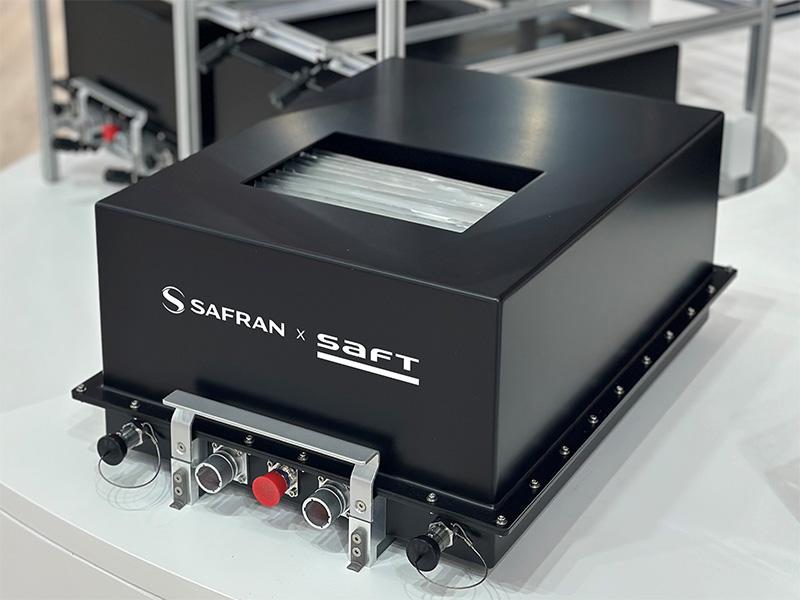Safran, Saft To Co-Develop 800V Battery For Hybrid-Electric Aircraft
Details
More Products & Services
Products & Services
Home - Aviation Group Marketing
Aviation Week Network
120 data points on over 156,000 commercial and business aviation aircraft, including military transports. Discover the most trustworthy resource for the complete aircraft history, plus ad hoc reports, month-over-month trend analysis and details on expected deliveries through 2050.
Aerospace | Aviation Week Network
Aviation Week Network
https://aviationweek.com/themes/custom/particle/dist/app-drupal/assets/awn-logo.svg
People

Andrea Rossi Prudente
Aviation Week Network

Anthony Lim
Aviation Week Network
Sales director

Becca Balmes
Aviation Week Network

Belinda Tan
Aviation Week Network

Brian Everstine
Aviation Week Network
Editor

Eddie Krankowski
Aviation Week Network
Assistant Manager, Tradeshows

erving dockery
Aviation Week Network

Lisa Tan
Aviation Week Network
Senior Marketing Manager

Mark Thomas
Aviation Week Network
Description
LE BOURGET—Safran and Saft have entered a partnership to develop an 800V battery essentially aimed at future hybrid-electric aircraft, to be ready for product launch before 2030.
Over the last 12 years or so, battery suppliers have consistently fallen behind the promised performance. Batteries have therefore been the weak link in aircraft propulsion hybridization—which might contribute to decarbonization—and ATR, for instance, has postponed the launch of its hybrid-electric EVO (evolution) regional turboprop. Boosted by the certification of its EngineUs electric motor in February, Safran intends to proceed with enabling hybridization and electrification.
The battery will use lithium-ion cells, themselves relying on lithium manganese ferro phosphate (LMFP) chemistry, Saft CEO Cedric Duclos said during an interview the week before the Paris Air Show. Specific energy (measured in energy content per weight unit), reliability and safety improvements are the main expected benefits.
The new battery will revolutionize onboard energy by delivering unprecedented power levels, the two companies said. It will improve thermal runaway containment, system management, and safety-related algorithms.
“It will open a field of possibilities,” said Bruno Bellanger, Safran Electrical & Power CEO. The collaboration is taking place in the framework of a strategic alliance that Safran and TotalEnergies (Saft's parent company) signed in 2021 to develop technical and commercial solutions to decarbonize aviation, with funding from the DGAC, the French civil aviation authority.
Safran and Saft are targeting technology readiness level 6 before the end of the decade, Bellanger noted. That degree of maturity, usually needed to launch a product development, will involve flight tests, he said. The main challenges lie in adapting LMFP battery technology to an aircraft environment, with its certification requirements.
In small regional aircraft with nine-19 seats, the battery could support all kinds of hybrid-electric architectures, including electric motors on the wing as part of a series hybrid layout. On 19- to 100-seat aircraft, it could enable parallel hybrid-electric configurations (with both a thermal engine and an electric motor driving a propeller or fan). On narrowbodies such as an A320 successor, it could also support hybridization, and the electrification of other systems, Bellanger explained.
Over the last 12 years or so, battery suppliers have consistently fallen behind the promised performance. Batteries have therefore been the weak link in aircraft propulsion hybridization—which might contribute to decarbonization—and ATR, for instance, has postponed the launch of its hybrid-electric EVO (evolution) regional turboprop. Boosted by the certification of its EngineUs electric motor in February, Safran intends to proceed with enabling hybridization and electrification.
The battery will use lithium-ion cells, themselves relying on lithium manganese ferro phosphate (LMFP) chemistry, Saft CEO Cedric Duclos said during an interview the week before the Paris Air Show. Specific energy (measured in energy content per weight unit), reliability and safety improvements are the main expected benefits.
The new battery will revolutionize onboard energy by delivering unprecedented power levels, the two companies said. It will improve thermal runaway containment, system management, and safety-related algorithms.
“It will open a field of possibilities,” said Bruno Bellanger, Safran Electrical & Power CEO. The collaboration is taking place in the framework of a strategic alliance that Safran and TotalEnergies (Saft's parent company) signed in 2021 to develop technical and commercial solutions to decarbonize aviation, with funding from the DGAC, the French civil aviation authority.
Safran and Saft are targeting technology readiness level 6 before the end of the decade, Bellanger noted. That degree of maturity, usually needed to launch a product development, will involve flight tests, he said. The main challenges lie in adapting LMFP battery technology to an aircraft environment, with its certification requirements.
In small regional aircraft with nine-19 seats, the battery could support all kinds of hybrid-electric architectures, including electric motors on the wing as part of a series hybrid layout. On 19- to 100-seat aircraft, it could enable parallel hybrid-electric configurations (with both a thermal engine and an electric motor driving a propeller or fan). On narrowbodies such as an A320 successor, it could also support hybridization, and the electrification of other systems, Bellanger explained.

Share
Recent Chats
Share via email
Future: handle WhatsApp here
Future: handle LinkedIn here
Future: handle Twitter here
SUBMENU HERE
Share via Chat
Copy Link

